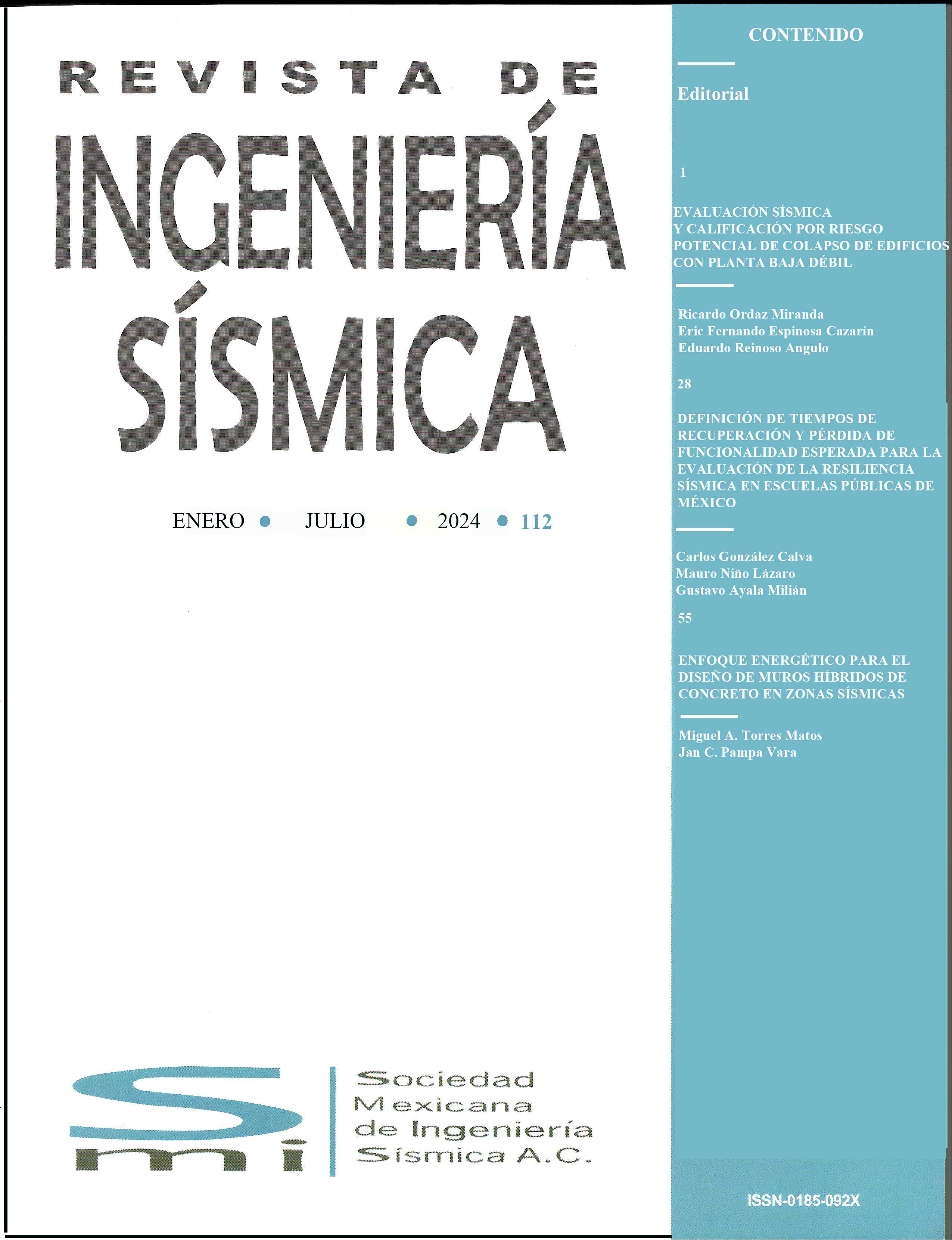UNA APROXIMACIÓN DE LA CURVA DE CAPACIDAD DINÁMICA Y SU APLICACIÓN A LA EVALUACIÓN SÍSMICA DE ESTRUCTURAS
DOI:
https://doi.org/10.18867/ris.110.620Palabras clave:
dynamic capacity curve, approximate procedures, incremental dynamic analysis, modal spectral analysis, seismic performanceResumen
En este artículo se presenta un procedimiento simplificado para la evaluación sísmica de estructuras fundamentado en la curva de capacidad dinámica, y en su validez como una propiedad estructural asociada a un tipo de demanda sísmica. El procedimiento permite estimar el desempeño de una estructura ante demandas sísmicas correspondientes a un espectro de peligro uniforme mediante una aproximación de la curva de capacidad dinámica construida a partir de análisis modales espectrales asociados a demandas de intensidad creciente. Para considerar la reducción de rigidez y la disipación de energía debida a histéresis se resuelve un oscilador de un grado de libertad con las características del modo fundamental. La aproximación de la curva de capacidad dinámica obtenida a partir del procedimiento propuesto se valida comparándola con la obtenida de análisis dinámicos paso a paso ante demandas de intensidades crecientes, para dos estructuras de concreto reforzado, un marco plano de 12 niveles irregular en elevación, y un puente continuo tipo viaducto.
Descargas
Citas
Alba F., Bento R. y Ayala A. G. (2005). Seismic performance evaluation of plane frames vertically regular and irregular. Proceedings of the Fourth European Workshop on the Seismic Behaviour of Irregular and Complex Structures. EAEE, Salónica, Grecia.
Antoniou S. y Pinho R. (2004b). Development and verification of a displacement-based adaptive pushover procedure. Journal of Earthquake Engineering 8:5, 643-661. DOI:10.1080/13632460409350504
Antoniu S. y Pinho R. (2004a). Advantages and limitations of adaptative and non adaptative force based pushover procedures. Journal of Earthquake Engineering 8:4, pp 497-522. DOI:10.1080/13632460409350498
Bañuelos-García F. (2013). “La curva de capacidad dinámicay su aplicación a la evaluación sísmica de estructuras”, Tesis de Maestría, Instituto de Ingeniería, UNAM.
ATC (1996). Seismic and evaluation of retrofit of concrete buildings. Technical report, ATC-40. Applied Technology Council. Redwood City, CA.
Aydinoglu, M. (2003). An incremental response spectrum analysis based on inelastic spectral displacements for multi-mode seismic performance evaluation. Bulletin of Earthquake Engineering 1:1,3-36. DOI:10.1023/A:1024853326383
CEN, Eurocode 8 (1994). Design of structures for earthquake resistance. Part 2: Bridges. Committee European of Normalisation, European Pre-standard. ENV1998-2.
CSI, (2007). Perform 3D V5. Nonlinear Analysis and Performance Assessment for 3D Structures. Computer and Structures, Inc. Berkeley, CA.
CSI, (2009). SAP2000: Three dimensional static and dynamic finite element analysis and design of structures. Computers and Structures Inc.: Berkeley, CA.
Chopra A.K. y Goel R.K. (2001). A Modal pushover analysis Procedure for estimating seismic demands for buildings, Earthquake Engineering and Structural Dynamics. Vol. 31, No 3, pp. 561-582. DOI:10.1002/eqe.144
Escamilla M. (2016). “Influencia de la evolución de las formas modales en el desempeño sísmico de estructuras irregulares, utilizando métodos aproximados de evaluación y diseño sísmico”, Tesis de Doctorado, Instituto de Ingeniería, UNAM.
Escamilla M.A, Reyna S.R y Ayala G.A (2022). Análisis Sísmico No-lineal de Edificios de Concreto Reforzado, Memorias del XXIII Congreso Nacional de Ingeniería Sísmica, Juriquilla, Querétaro, México.
Fajfar, P. y Gaspersic, P. (1996), The N2 method for the seismic damage analysis of RC buildings, Earthquake Engineering and Structural Dynamics, 25(1), 31-46. DOI:10.1002/(SICI)1096-9845(199601)25:1<31::AID-EQE534>3.0.CO;2-V
FEMA (2005). FEMA 440 - Improvement of nonlinear static seismic analysis procedures, Federal Emergency Management Agency, Washington D.C.
Fragiadakis M. y Vamvatsikos D. (2011). Qualitative comparison of static pushover versus incremental dynamic analysis capacity curves, Proceedings of the 7th Hellenic National Conference on Steel Structures, Volos, Grecia.
Freeman, S.A. (1978). Prediction of response of concrete buildings to severe earthquake motions. American Concrete Institute, Special Publication SP-55, 589-606. DOI:10.14359/6629
GCDMX (2017), Normas Técnicas Complementarias para el Diseño de Estructuras de Concreto Reforzado, NTC-EC, Gaceta del Gobierno de la CDMX, México.
GCDMX (2017), Normas Técnicas Complementarias para el Diseño por Sismo, NTC-DS, Gaceta del Gobierno de la CDMX, México.
INN (2009), NCh 433 Diseño Sísmico de edificios”. Instituto Nacional de Normalización, Chile
Mendoza, M. y Ayala A.G. (2013). Procedimiento de Evaluación de Edificios de Concreto Reforzado Basado en Desempeño: Desarrollo y Validación. Revista de Ingeniería Sísmica, No. 88 23-41. DOI:10.18867/ris.88.8
Requena, M. y Ayala A.G. (2000). Evaluation of a simplified method for determination of the nonlinear seismic response of RC frames. Proceedings of the XII World Conference on Earthquake Engineering. Paper No 2109.
SENCICO (2013). Norma Técnica de Edificaciones NTE-E.030 Diseño Sismo resistente. Servicio Nacional de Normalización, Capacitación e Investigación para la Industria de la Construcción. Lima, Perú.
Vamvatsikos, D. y Cornell, C.A. (2002). Incremental dynamic analysis. Earthquake Engineering and Structural Dynamics 31:3, 491-514. DOI:10.1002/eqe.141

Descargas
Publicado
Cómo citar
Número
Sección
Licencia
Derechos de autor 2023 Revista de Ingeniería Sísmica

Esta obra está bajo una licencia internacional Creative Commons Atribución-NoComercial 4.0.






